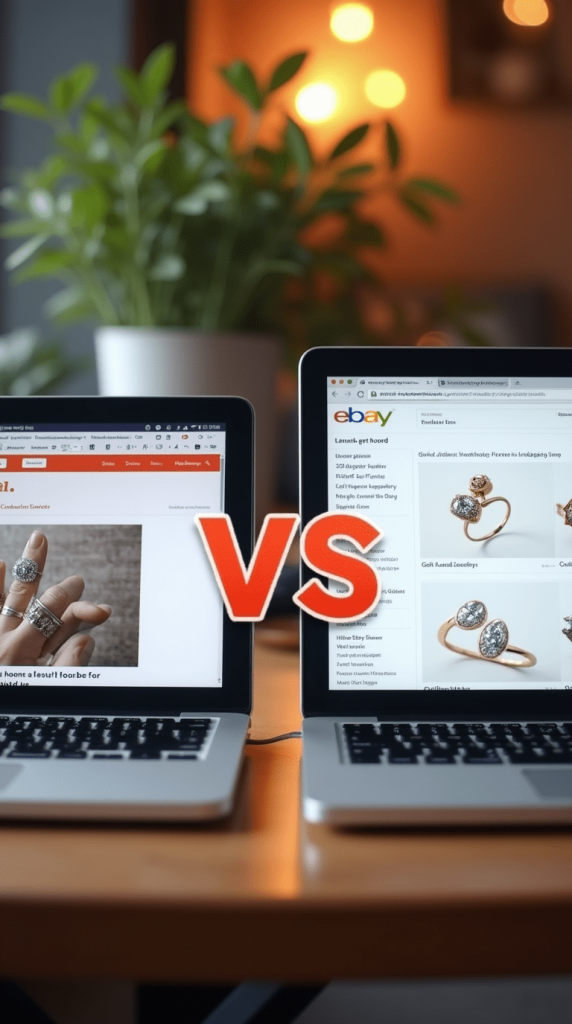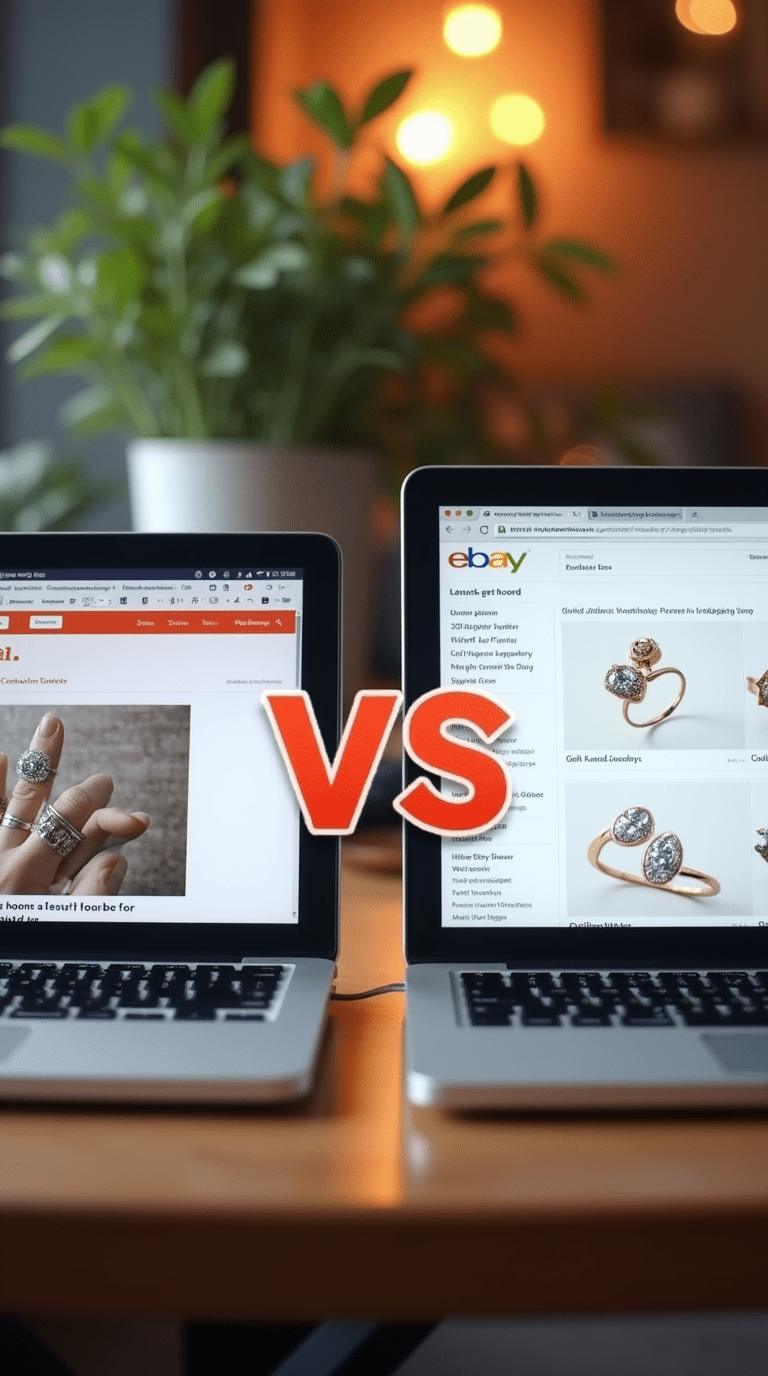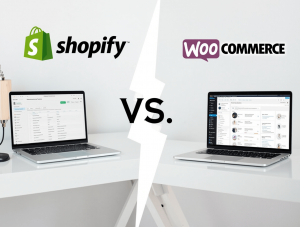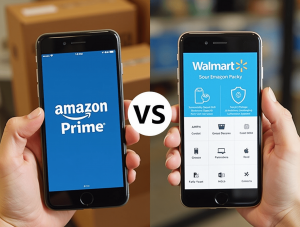
The handmade goods market has experienced remarkable growth, with global valuation reaching $718 billion in 2024 and projections suggesting it will surpass $1 trillion by 2027. For artisans and crafters seeking to capitalize on this expanding market, choosing the right selling platform represents a critical business decision that directly impacts visibility, sales potential, and profitability.
Many handmade sellers find themselves deliberating between Etsy—a marketplace specifically designed for unique and handcrafted items—and eBay—a general marketplace with massive reach and flexible selling options. This choice involves navigating complex considerations around fees, audience targeting, visibility algorithms, and platform-specific policies that can significantly influence business outcomes.
This comprehensive analysis examines both platforms through the specific lens of handmade sellers, evaluating their distinct advantages, limitations, and operational requirements. By assessing these marketplaces across critical factors including fee structures, target demographics, promotion capabilities, and seller tools, we will provide actionable insights to help you determine which platform aligns best with your particular handmade business model and growth objectives.
Platform Overviews
Etsy’s Handmade Focus
Etsy launched in 2005 with an explicit mission to create an online marketplace for handmade, vintage, and craft supplies. The platform has grown substantially since then, now hosting over 5.5 million active sellers and 90 million active buyers as of 2025.
Etsy’s core identity revolves around uniqueness, craftsmanship, and personal connection between creators and consumers. Its marketplace architecture, search functionality, and marketing strategies are specifically optimized for showcasing one-of-a-kind items and the stories behind them. This specialized focus has created a destination marketplace where consumers specifically seek handmade alternatives to mass-produced products.
Significantly, Etsy implemented more stringent handmade policies in 2013 that require sellers to be directly involved in the creation process or transparently disclose production partnerships. These policies aim to maintain marketplace integrity and consumer trust in the authenticity of handmade claims.
eBay’s General Marketplace Approach
Founded in 1995, eBay originated as an auction platform before evolving into a diverse marketplace that accommodates virtually all product categories. With approximately 138 million active buyers worldwide, eBay offers remarkable reach and visibility potential for sellers of all types.
Unlike Etsy, eBay does not prioritize or specifically cater to handmade sellers in its platform architecture or marketing. Handmade items represent just one among countless product categories, sitting alongside new retail items, used goods, collectibles, and commercially manufactured products from major brands and retailers.
This generalist approach means handmade sellers must compete with mass-produced alternatives and commercial sellers within the broader marketplace ecosystem. However, it also provides access to a more diverse consumer base not explicitly seeking handmade items but potentially open to discovering them during broader shopping searches.
Fee Structure and Profitability
Etsy’s Fee Model
Etsy’s fee structure is specifically calibrated for individual creators and small businesses:
Listing Fees:
- $0.20 per listing (valid for 4 months)
- Automatic renewal fee of $0.20 when listings expire
- Multi-quantity listings incur only one listing fee
Transaction Fees:
- 6.5% of total sale price (including shipping)
- Payment processing fee of 3% + $0.25 per transaction
Additional Potential Costs:
- Offsite Ads fee: 12% for sellers making under $10,000/year (mandatory for sellers over $10,000/year)
- Etsy Ads program (optional): customizable daily budget
- Etsy Plus subscription: $10/month for additional tools and credits
For a typical handmade item priced at $50 with $5 shipping, Etsy fees would amount to approximately $5.95 (listing fee + transaction fee + payment processing), representing about 10.8% of the total sale value.
eBay’s Fee Structure
eBay employs a more complex fee structure that varies by category and selling format:
Listing Fees:
- 250 free listings per month for non-store sellers
- Additional listings: $0.35 each
- Store subscribers receive between 250-100,000 free listings depending on subscription level
Final Value Fees:
- For most handmade categories: 12.9% of total sale price + $0.30 per order
- Maximum fee cap of $750
- Higher percentages for certain categories
Store Subscription Options:
- Starter: $7.95/month (annual plan)
- Basic: $27.95/month
- Premium: $74.95/month
- Higher tiers available for larger volume sellers
Additional Potential Costs:
- Promoted Listings (optional): ad rate percentage set by seller
- International fees and currency conversion charges
- Optional listing upgrades (subtitle, scheduled listing, etc.)
For the same $50 item with $5 shipping, eBay fees would typically total approximately $7.40, representing about 13.5% of the total sale value.
Comparative Profitability Analysis
When comparing the platforms purely on fee basis:
- Basic Fee Comparison: Etsy’s combined fees are generally 2-3% lower than eBay’s for comparable handmade items.
- Volume Considerations: eBay becomes more cost-effective for high-volume sellers through store subscription discounts and free listing allowances.
- Price Point Impact: Etsy’s percentage-based model favors lower-priced items, while eBay’s fee caps benefit higher-priced handmade goods.
- Hidden Costs: Etsy’s mandatory Offsite Ads program for successful sellers can significantly impact profitability once the $10,000 threshold is reached.
- Payment Processing: Etsy’s integrated payment system simplifies operations but offers less flexibility than eBay’s multiple payment options.
For most small to medium handmade sellers, Etsy’s fee structure typically results in slightly higher profit margins, particularly for items priced under $100. However, this advantage may be offset by other factors including visibility, conversion rates, and audience alignment.
Target Audience and Market Positioning
Etsy’s Specialized Audience
Etsy has successfully cultivated a dedicated audience specifically seeking alternatives to mass-produced goods:
Demographic Profile:
- Predominantly female (81% of buyers)
- Higher concentration in 25-45 age bracket
- Above-average household income
- Higher education levels
- Strong preference for sustainability and uniqueness
- Willingness to pay premium for handmade quality
Shopping Behaviors:
- Intentionally seeking handmade, unique, or customized items
- Higher appreciation for craftsmanship and maker stories
- More likely to value ethical production and sustainability
- Often shopping for gifts or special occasions
- Greater interest in direct creator connections
Marketplace Expectations:
- Authenticity in handmade claims
- Unique items not available in retail channels
- Personal communication with creators
- Customization options
- Understanding of handmade pricing models
This specialized audience creates an environment where handmade products are valued for their uniqueness rather than competing primarily on price with mass-produced alternatives.
eBay’s Broad Consumer Base
eBay attracts a more diverse and generalized shopping audience:
Demographic Profile:
- More gender-balanced (56% male)
- Broader age distribution
- More diverse income levels
- Deal and value orientation
- Less specific focus on handmade as a value proposition
Shopping Behaviors:
- Often comparison shopping across multiple product types
- More price-sensitive purchasing decisions
- Greater emphasis on practical considerations over uniqueness
- Strong focus on seller ratings and reviews
- Less consistent interest in maker stories or processes
Marketplace Expectations:
- Competitive pricing
- Professional fulfillment and shipping
- Responsive customer service
- Detailed product specifications
- Product standardization and consistency
This broader audience provides access to consumers who may not specifically seek handmade items but might purchase them when presented alongside alternatives.
Conversion Potential Analysis
Research indicates significant differences in how these audiences convert for handmade sellers:
- Intent Factor: Etsy shoppers convert at rates 2-3x higher for handmade items compared to eBay shoppers, primarily due to intentional handmade-focused shopping.
- Price Sensitivity: eBay buyers exhibit approximately 15% greater price sensitivity when comparing similar handmade items to commercial alternatives.
- Value Perception: Etsy buyers demonstrate greater willingness to pay premium prices for handmade quality, with average price points for comparable handmade items typically 20-30% higher than on eBay.
- Repeat Purchase Behavior: Etsy generates higher return customer rates for handmade sellers (approximately 30% versus eBay’s 15-20% for similar products).
These conversion differences suggest that while eBay offers greater raw traffic potential, Etsy’s more targeted audience often delivers superior conversion rates and higher average order values for handmade sellers.
Visibility and Discovery Mechanisms
Etsy’s Discovery System
Etsy’s search and discovery mechanisms are specifically optimized for unique items:
Search Algorithm Factors:
- Relevancy based on keywords, tags, and categories
- Listing quality score
- Recency of listing creation or renewal
- Customer and market experience score
- Shipping price and speed
- Contextual factors like shopper location and behavior
Discovery Features:
- Personalized recommendations based on browsing history
- Curated collections and editorial picks
- Category-specific browsing paths
- “You might also like” related item suggestions
- Shop recommendations for similar aesthetics
Differentiating Elements:
- Recognition and weighting of handmade-specific attributes
- Greater SEO visibility for craft-focused search terms
- Discovery features designed for unique/non-standardized products
- Less direct price competition in search results
- Shop identity prominence in the shopping experience
These systems work favorably for handmade sellers by emphasizing unique attributes rather than primarily sorting on price or standardized specifications.
eBay’s Search and Marketing Approach
eBay employs a more standardized e-commerce discovery system:
Search Algorithm Factors:
- Keyword relevance and listing title optimization
- Best Match algorithm weighing conversion probability
- Seller performance metrics
- Shipping cost and speed
- Price competitiveness
- Promoted listings placement
Discovery Features:
- Category navigation with standardized hierarchies
- Deal-focused promotions and features
- Recently viewed items
- Watch count visibility
- Auction and time-limited purchase prompts
Differentiating Elements:
- Greater emphasis on price comparison
- Established product categories favored over unique items
- Standardized product identifiers preferred
- More direct competition with commercial products
- Greater emphasis on objective specifications
This approach can create visibility challenges for handmade items that don’t easily conform to standardized categories or compete primarily on unique attributes rather than price or specifications.
Visibility Strategy Requirements
These platform differences necessitate distinct approaches to achieve optimal visibility:
Etsy Optimization Strategy:
- Focus on uniqueness and handmade aspects in listings
- Develop comprehensive tags capturing style and attributes
- Create narrative descriptions emphasizing creation process
- Invest in high-quality, lifestyle-oriented photography
- Maintain consistent listing additions or renewals
- Encourage reviews that highlight uniqueness and quality
eBay Optimization Strategy:
- Emphasize keywords and specific item descriptions
- Focus on competitive pricing or unique value proposition
- Optimize for mobile search visibility
- Consider Promoted Listings for key products
- Maintain high seller performance metrics
- Develop specialized categories or utilize existing niche categories
Successful sellers often report the need for platform-specific listing strategies rather than identical cross-platform approaches, with Etsy generally requiring more attention to storytelling and uniqueness while eBay demands greater focus on competitive positioning and technical optimization.
Seller Tools and Business Growth
Etsy’s Creator-Focused Tools
Etsy provides tools specifically designed for small creative businesses:
Production Management:
- Order management dashboard
- Production partner disclosure system
- Bulk listing tools
- Listing variation options for customized items
- Shop announcement features
Marketing Capabilities:
- Etsy Ads platform with marketplace placement
- Offsite Ads program with performance-based fees
- Social media integration tools
- Sale event and coupon creation
- Shop SEO tools and guidance
Analytics Support:
- Shop stats with traffic sources
- Listing performance metrics
- Search query analytics
- Conversion rate tracking
- Buyer behavior insights
Growth Resources:
- Etsy Seller Handbook with specialized guidance
- Etsy Community forums for peer learning
- Etsy Success newsletter with marketplace insights
- Regular shop improvement prompts and guidance
- Team support for established sellers
These tools align well with the needs of individual creators and small production operations, though they may lack some capabilities needed by larger-scale businesses.
eBay’s Commercial Seller Tools
eBay offers robust tools designed primarily for commercial operations:
Inventory Management:
- Seller Hub with comprehensive dashboard
- Bulk listing and management tools
- Integration with inventory management systems
- Multi-channel selling support
- Business policies for standardized operations
Marketing Resources:
- Promoted Listings Standard and Advanced
- Markdown Manager for sales and promotions
- Store marketing tools and email capabilities
- Cross-selling features and bundle options
- Direct coupon offers to buyers
Performance Analytics:
- Traffic and conversion metrics
- Competitor performance benchmarking
- Search term optimization suggestions
- Performance against category averages
- Detailed financial reporting
Growth Support:
- eBay for Business podcast and resources
- Seller School with online courses
- Growth opportunities in international markets
- Dedicated account management (volume-dependent)
- Structured data initiatives for improved visibility
These tools provide robust support for volume-focused businesses but may include unnecessary complexity for small handmade operations with limited production capacity.
Scalability Comparison
The platforms offer different growth trajectories for handmade businesses:
Etsy Scalability Pathway:
- Natural progression from individual creator to small production team
- Expanding through production partnerships with maintained transparency
- Growth limited by handmade policy requirements
- Potential expansion to Etsy Wholesale for B2B opportunities
- Multichannel selling through Etsy Pattern website option
eBay Scalability Pathway:
- Unlimited growth potential without production method restrictions
- Progressive store subscription levels as volume increases
- International selling program for global expansion
- Greater compatibility with inventory management systems
- Managed Payments system for financial scaling
Business Model Implications:
- Etsy inherently constrains growth that moves away from handmade fundamentals
- eBay accommodates transition from handmade to small manufacturing
- Etsy provides more structured support for early-stage growth
- eBay offers more robust tools for high-volume operations
- Platform alignment shifts as businesses evolve in production capacity
These differences suggest that business growth ambitions should factor heavily into platform selection, with Etsy generally providing better support for businesses committed to remaining primarily handmade while eBay offers fewer constraints on production scaling.
Marketplace Policies and Requirements
Etsy’s Handmade Standards
Etsy maintains specific policies that directly impact handmade sellers:
Handmade Definition Requirements:
- Items must be made or designed by the shop owner
- Production assistance must be disclosed
- Production partners must be identified and approved
- Reselling of commercial goods is prohibited
- Vintage items must be at least 20 years old
Listing Content Standards:
- Photos must represent the actual handmade item
- Made-to-order timelines must be accurately disclosed
- Custom orders must clearly state customization limitations
- Intellectual property rights must be respected
- Claims about materials and production must be accurate
Operational Compliance:
- Accurate representation of production capacity
- Transparent communication of processing times
- Shipping timeline adherence
- Consistent brand representation
- Required disclosure of business location
These policies create a more protective environment for genuine handmade sellers but impose constraints that may limit certain business models or production methods.
eBay’s General Marketplace Rules
eBay employs broader marketplace policies:
Seller Performance Standards:
- Consistent on-time shipping metrics
- Low rate of item not as described claims
- Quick resolution of customer issues
- Accurate product descriptions
- Compliance with category-specific requirements
Listing Requirements:
- No restrictions on production methods
- Clear identification of condition (new, used, etc.)
- Accurate representation of item being sold
- Reasonable shipping costs and timelines
- Compliance with prohibited items policies
Operational Expectations:
- Professional customer service standards
- Consistent adherence to stated policies
- Competitive market practices
- Intellectual property compliance
- Tax and regulatory compliance
These broader policies provide greater flexibility in production methods and business models but offer less protection from competition with mass-manufactured goods marketed as handmade.
Policy Impact Assessment
The differing policy approaches create distinct marketplace environments:
- Authenticity Protection: Etsy’s policies provide stronger safeguards against competition from resellers representing commercial goods as handmade.
- Production Flexibility: eBay imposes fewer restrictions on how items are produced, allowing for more scalable production methods.
- Enforcement Consistency: Sellers report varied experiences with policy enforcement on both platforms, with Etsy generally showing stricter enforcement of handmade requirements.
- Customer Expectations: Etsy’s policies help shape buyer expectations regarding what constitutes handmade, while eBay’s broader approach creates more variable buyer expectations.
- Business Model Alignment: Policy considerations should align with your production methods and business identity—pure handmade crafters typically find better policy alignment on Etsy, while those employing more scalable production often prefer eBay’s flexibility.
Customer Interaction and Community
Etsy’s Community Orientation
Etsy has cultivated a marketplace that emphasizes connection between creators and buyers:
Communication Features:
- Messaging system with order-specific context
- Custom order request functionality
- Shop announcement capabilities
- Update notifications to interested customers
- Community forums for both buyers and sellers
Customer Relationship Development:
- Shop “About” section for storytelling
- Team member biographies
- Production process sharing
- Materials and sustainability information
- Behind-the-scenes content opportunities
Community Engagement:
- Local Etsy teams and events
- Virtual craft fairs and showcases
- Etsy-sponsored promotion opportunities
- Editorial features and seller spotlights
- Seller education and community support
This community orientation creates opportunities for brand storytelling and customer relationship development that particularly benefit handmade businesses.
eBay’s Transaction Focus
eBay’s platform emphasizes efficient transactions over community building:
Communication Systems:
- Message system focused on transaction details
- Question and answer functionality on listings
- After-sale communication tools
- Feedback and resolution processes
- Limited shop narrative capabilities
Customer Relationship Structure:
- Feedback profile as primary reputation system
- Business policies for standardized interactions
- Limited storytelling capabilities in listings
- Store design options for established sellers
- Follow feature for repeat customers
Community Elements:
- Community answer boards
- Limited seller-to-seller interaction systems
- eBay for Business podcast and content
- Category-specific best practices guidance
- Seller community forums
This transaction-focused approach streamlines the selling process but provides fewer opportunities for the personal connection that often differentiates handmade businesses.
Relationship Building Potential
The platforms offer different capacities for customer relationship development:
- Brand Storytelling: Etsy provides more robust infrastructure for communicating creation processes and maker stories that justify handmade pricing.
- Customer Loyalty: Etsy shops typically achieve higher return customer rates (approximately 30% vs. 15-20% on eBay for similar products).
- Communications Efficiency: eBay’s streamlined communication system requires less management but offers fewer relationship-building touchpoints.
- Community Support: Etsy sellers often report stronger peer support through platform communities compared to eBay’s more competitive seller environment.
- Customer Expectations: Etsy buyers typically expect and value personal communication, while eBay buyers more often prioritize transaction efficiency over connection.
These differences significantly impact the customer experience and should align with your preferred business communication style and capacity for relationship management.
Branding and Identity Development
Etsy’s Shop Identity Focus
Etsy provides infrastructure that supports distinctive maker identities:
Branding Elements:
- Shop banner and icon customization
- About section with story and process information
- Shop announcement for timely updates
- Sections for organizing product collections
- Featured listings selection
- Shop policies with personalized voice
Identity Differentiation:
- Shop-level branding distinct from Etsy marketplace
- Customizable shop URL
- Ability to showcase creation process
- Team member profiles for larger operations
- Shop story featured prominently
Customer Perception:
- Shop identity given prominence in customer experience
- Shop cohesion recognized in algorithm and features
- Stronger connection between maker and products
- Greater emphasis on creator as brand
- Shop name recognition potential within marketplace
This structure supports development of a recognizable maker identity that can eventually translate to independent brand growth.
eBay’s Item-Centric Approach
eBay’s structure emphasizes individual items over seller identity:
Branding Capabilities:
- Store design options (with subscription)
- Limited listing design customization
- Standardized layout with minimal branding space
- Profile information in secondary position
- Business policies for consistent experience
Identity Positioning:
- Individual listings prioritized over shop identity
- Search results minimize seller brand visibility
- Limited storytelling space in standard templates
- Feedback score as primary trust indicator
- Greater focus on product than producer
Customer Perception:
- Transaction-focused rather than relationship-focused
- Product discovery typically separate from seller discovery
- Item specifications prioritized over creator connection
- Greater emphasis on price and specifications than story
- Reduced brand recognition within marketplace
This structure optimizes for transaction efficiency but provides less support for developing a distinctive maker identity or brand narrative.
Brand Development Implications
These structural differences create divergent brand development paths:
- Brand Recognition: Etsy more effectively supports developing recognizable handmade brands within the marketplace ecosystem.
- Independence Pathway: Both platforms can serve as launching points for independent websites, but Etsy’s stronger branding capabilities often provide better foundation.
- Marketing Asset Development: Etsy’s structure encourages creation of brand storytelling assets that remain useful if migrating to independent platforms.
- Customer Attribution: Customers on Etsy more commonly remember and seek specific shops, while eBay customers more often recall products rather than sellers.
- Long-Term Brand Value: Handmade businesses planning eventual independence or multichannel strategies typically find Etsy’s brand-building capabilities more advantageous.
International Selling Capabilities
Etsy’s Global Marketplace
Etsy offers a unified global marketplace with specific international features:
Global Infrastructure:
- Single marketplace with worldwide exposure
- Currency conversion display for buyers
- Language translation tools
- International shipping profile options
- Location-specific search visibility
Market Access:
- Strongest presence in US, UK, Canada, Australia, and European markets
- Growing presence in Asian markets
- Global payments processing
- Location-based search result prioritization
- International marketing campaigns
Operational Considerations:
- Simplified international shipping options
- Currency conversion during payment processing
- VAT/GST collection and remittance services
- International SEO optimization
- Global customer service expectations
Etsy provides relatively streamlined international selling with minimal additional complexity beyond domestic sales.
eBay’s Country-Specific Marketplaces
eBay operates distinct marketplaces for different countries:
Global Structure:
- Separate marketplaces for major countries/regions
- Individual listing creation for each marketplace
- Country-specific seller requirements
- Varied fee structures by marketplace
- Global Shipping Program for simplified logistics
Market Penetration:
- Strong presence in US, UK, Germany, Australia, and Canada
- Established marketplaces in numerous European countries
- Strategic positions in select Asian markets
- Country-specific promotions and features
- Localized marketing and category emphasis
Operational Requirements:
- More complex cross-border selling processes
- Varied payment methods by market
- Country-specific compliance requirements
- Multiple marketplace management needs
- International returns considerations
eBay’s international infrastructure offers more precise targeting of specific countries but requires greater management complexity and potentially multiple listings.
Cross-Border Selling Assessment
International capabilities comparison reveals several key differences:
- Startup Complexity: Etsy provides simpler international entry with automatic global visibility, while eBay may require separate marketplace setups.
- Language Requirements: Both platforms offer translation tools, but eBay’s country-specific marketplaces may demand more language customization for optimal results.
- Shipping Integration: eBay’s Global Shipping Program offers simplified international logistics, while Etsy requires more direct shipping management.
- Compliance Handling: Etsy provides more centralized VAT/GST management, while eBay’s varied marketplaces may require country-specific compliance strategies.
- Market Strength Variations: Etsy shows stronger handmade positioning in North America and Western Europe, while eBay has more established presence in certain international markets including Germany and Australia.
Handmade sellers with specific international target markets should evaluate platform strength in those regions as part of their decision process.
Platform Stability and Future Outlook
Etsy’s Strategic Direction
Etsy’s marketplace positioning and recent developments suggest its future trajectory:
Recent Developments:
- Increasing focus on sustainability and ethical production
- Expansion of production partner capacities
- Growing emphasis on offsite advertising programs
- Mobile shopping experience enhancements
- Improvements in search algorithm sophistication
Strategic Signals:
- Continued commitment to handmade as core identity
- Integration of more sophisticated seller tools
- Increasing competition with mainstream e-commerce
- Expanding into adjacent categories while maintaining craft focus
- Greater investment in seller success resources
Risk Factors:
- Seller fee increases in recent years
- Growing competition from other handmade marketplaces
- Mandatory advertising program controversies
- Periodic marketplace policy adjustments
- Expanding expectations for seller performance metrics
Etsy appears positioned to maintain its handmade marketplace focus while gradually expanding seller tools and requirements to compete with larger e-commerce platforms.
eBay’s Evolution and Direction
eBay’s strategic positioning continues to evolve:
Recent Initiatives:
- Structured data improvements for better search
- Managed Payments implementation
- Authentication services for select categories
- Moving toward more Amazon-like standardization
- Greater focus on consumer electronics and mainstream retail categories
Strategic Indicators:
- Continued movement toward managed marketplace model
- Increasing seller performance requirements
- Growing competition with Amazon and Walmart
- Investment in mobile commerce capabilities
- Category-specific focused initiatives
Risk Considerations:
- Declining emphasis on unique/individual sellers
- Increased competitive pressure from multiple platforms
- Periodic significant policy changes
- Category strategy shifts affecting visibility
- Marketplace identity less clearly differentiated
eBay appears to be positioning itself more directly against major retail marketplaces while maintaining some distinctive elements of its consumer-to-consumer heritage.
Stability Comparison for Handmade Sellers
Platform stability factors relevant to handmade businesses include:
- Category Prioritization: Etsy’s core identity remains aligned with handmade categories, while eBay’s emphasis on these categories fluctuates with broader market strategies.
- Policy Consistency: Both platforms implement periodic policy changes, with Etsy’s changes typically more focused on maintaining handmade marketplace integrity.
- Fee Structure Evolution: Both platforms have increased fees over time, with Etsy implementing more significant percentage changes but from a lower base rate.
- Algorithm Stability: Sellers report more frequent visibility fluctuations on eBay compared to Etsy, particularly following algorithm updates.
- Competitive Pressure: Etsy faces increasing competition from specialized handmade marketplaces, while eBay contends with general marketplace competition affecting its overall strategy.
These stability factors suggest that while both platforms continue evolving, Etsy’s changes typically remain more aligned with handmade seller interests due to its market positioning.
Optimal Strategies Based on Business Type
Ideal Scenarios for Etsy
Etsy typically proves most advantageous for specific seller profiles:
Business Types Best Suited for Etsy:
- Individual artisans and craftspeople
- Small production teams maintaining handmade methods
- Businesses emphasizing unique design and craftsmanship
- Sellers of higher-priced, distinctive handmade items
- Makers with compelling creation stories or processes
- Businesses focusing on sustainability or ethical production
- Creators with limited technical or marketing experience
Product Categories with Strongest Etsy Performance:
- Personalized and custom products
- Home decor and furnishings
- Jewelry and accessories
- Art and collectibles
- Paper goods and stationery
- Wedding and celebration items
- Craft supplies for other makers
Business Models Aligned with Etsy:
- Studio-based production with limited scaling
- Made-to-order with customization options
- Limited edition collections with storytelling
- Transparent production partnerships
- Creative business with personal brand emphasis
Ideal Scenarios for eBay
eBay generally provides better alignment for different business profiles:
Business Types Best Suited for eBay:
- Production-focused handmade businesses
- Makers with scalable production methods
- Sellers competing primarily on price point
- Handmade businesses with standardized products
- Vintage sellers who also offer handmade items
- Makers with international target markets
- Sellers with technical comfort and marketing experience
Product Categories with Strongest eBay Performance:
- Handmade with practical/functional focus
- Craft items with mainstream appeal
- Handcrafted versions of commercial products
- DIY and maker supplies
- Handmade electronics or technical items
- Automotive or sports-related handmade goods
- Personalized versions of common products
Business Models Aligned with eBay:
- Batch production with efficiency focus
- Standardized handmade with limited variation
- Combination of handmade and commercial offerings
- Production scaling beyond personal creation
- Business-focused approach over creator identity
Hybrid and Multichannel Strategies
Many successful handmade businesses implement strategic approaches spanning both platforms:
Effective Cross-Platform Strategies:
- Using Etsy for unique/high-margin items and eBay for more standardized offerings
- Testing new product concepts on Etsy before scaling to eBay
- Leveraging Etsy for brand building while using eBay for volume
- Utilizing platform-specific listing optimization for each marketplace
- Implementing different pricing strategies appropriate to each platform’s audience
Multichannel Challenges to Address:
- Inventory management across platforms
- Consistent brand presentation with platform-appropriate adjustments
- Varied customer service expectations
- Platform-specific policy compliance
- Time management across multiple marketplaces
Long-Term Multichannel Considerations:
- Gradual testing and expansion rather than simultaneous launch
- Platform-specific metrics to evaluate performance
- Recognition of different success factors by platform
- Consistent fulfillment experiences across channels
- Development of channel-specific marketing strategies
A thoughtful multichannel approach often provides the optimal solution for established handmade businesses, allowing them to capture the advantages of each platform while minimizing limitations.
Conclusion: Making the Right Choice for Your Handmade Business
The decision between Etsy and eBay for selling handmade goods should be guided by your specific business model, product type, growth objectives, and operational preferences rather than seeking a universally superior platform.
Etsy presents compelling advantages for businesses focused on uniqueness, craftsmanship, and creator identity. Its specialized audience, handmade-optimized features, and community orientation create an environment where authentic handmade products receive appropriate valuation and appreciation. For individual artisans and small creative teams committed to handmade processes, Etsy typically provides better alignment with both practical needs and philosophical values.
eBay offers significant benefits for production-focused handmade businesses seeking broader market access and scalable operations. Its massive audience, flexible policies, and commercial-grade tools support growth beyond strictly handmade limitations. For businesses with standardized production methods, competitive pricing strategies, or ambitions beyond individual creation, eBay’s infrastructure may better accommodate long-term objectives.
For many sellers, the optimal approach evolves over time—perhaps beginning with Etsy’s supportive environment for handmade businesses before expanding to eBay’s broader marketplace as production capabilities grow. Alternatively, using both platforms strategically for different product lines or business objectives can maximize the unique advantages each provides.
Whatever your choice, success on either platform ultimately depends on understanding its specific ecosystem, audience expectations, and operational requirements—then developing strategies that align your unique handmade business with the platform’s particular strengths while mitigating its limitations.
Frequently Asked Questions
Which platform has lower fees for handmade sellers?
Etsy typically offers slightly lower overall fees for standard handmade items, with approximately 10.8% in combined fees compared to eBay’s roughly 13.5%. However, this calculation changes based on price point, selling volume, and optional services on both platforms.
Can I sell the same items on both Etsy and eBay simultaneously?
Yes, there are no restrictions preventing concurrent listing on both platforms. Many successful handmade sellers maintain presence on both marketplaces, though this requires additional inventory management and potentially platform-specific listing optimizations.
Which platform offers better protection against copies and counterfeits?
Etsy’s stricter handmade policies theoretically provide better protection against mass-produced copies, though enforcement varies. Both platforms have intellectual property protection systems, but neither completely eliminates the risk of design copying or misrepresentation.
How do shipping expectations differ between platforms?
eBay buyers typically expect faster shipping with tracking information as standard practice. Etsy customers often demonstrate greater patience with shipping timeframes, particularly for made-to-order items, but still expect clear communication about processing times.
Which platform is better for international sellers?
This depends on target markets. Etsy provides simpler global selling through one unified marketplace but has stronger presence in North America and Western Europe. eBay offers more established marketplaces in countries like Germany and Australia but requires more complex multi-marketplace management.
Do I need separate branding and photography for each platform?
While core branding should remain consistent, optimizing presentation for each platform’s specific audience and algorithm typically improves results. Etsy benefits from lifestyle-oriented photography and stronger brand storytelling, while eBay often performs better with detailed, specification-focused imagery and descriptions.














